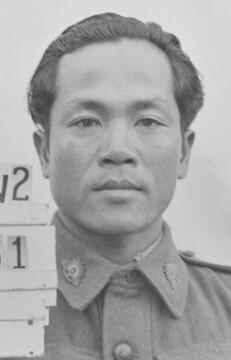ABU, Kassim
| Service Number: | WX36796 |
|---|---|
| Enlisted: | 6 March 1944 |
| Last Rank: | Sergeant |
| Last Unit: | Not yet discovered |
| Born: | BERAUANG ULU, BRITISH MALAYA, date not yet discovered |
| Home Town: | Not yet discovered |
| Schooling: | Not yet discovered |
| Occupation: | Not yet discovered |
| Memorials: | Broome Z Special Unit Memorial |
World War 2 Service
| 6 Mar 1944: | Enlisted Australian Military Forces (WW2) , Sergeant, WX36796 | |
|---|---|---|
| 9 Oct 1946: | Discharged Australian Military Forces (WW2) , Sergeant, WX36796 |
Story: Abu Kassim
Abu Kassim Bin Marah (WX36796), originally from Berauang Ulu, Malaya, was a Malay pearler employed in Western Australia. He enlisted in 1942 at the Fraser Commando School Queensland. As a Sergeant, he served in the Australian Army in the ‘Z’ Special Unit. Before joining the AIF in 1942, Abu Kassim, as a seaman, impressed the RAN with his skills saving pearling luggers and their crews from drowning in waters near Broome. His language skills were also welcomed by the AIF authorities and subsequently he enrolled in a course at the Fraser Commando School. Then, he was sent to Borneo as a member of the first batch of paratroopers.
In his, Z Special Unit Semut Operation – Borneo 1945: A Personal Memoir, Keith Barrie made a note of Corporal Abu Kassim, his fellow soldier in ‘Z’ Unit through a series of reconnaissance operations as part of the Borneo Campaign, against the Japanese. Operation Semut was one of Australia’s first independent special forces operations which took place behind Japanese lines. Its objective was to recruit the native Dayak people and to wage guerrilla warfare against the Japanese. Abu and his comrades worked through various parts of the island gaining information which was passed on to the right quarter by underground routes. His geographical knowledge of locations and interpreting skills were assets for the operations.
Kassim’s military observation of a region was to locate the enemy and ascertain strategic features. In one of his operations, he travelled through the river all night by prahu (Malay boat), reaching Kuala Sungei Pila. The following day he set up a camp of jungle hammocks. He was sent back to Belaga to hold that position and keep an eye on developments in Long Akah, Long Lengaleh, Long Seniai and Belaga. Abu and his comrades met native Dayak tribes whose initial ambivalence against Japanese forces rapidly turned to strong hostility against them, rejecting Javanese ‘Asian brotherhood’ in the way of their occupying forces. At the same time, Australian soldiers won support for the guerrilla operation by the Dayak people without which the whole operation would have been disastrous. Japanese bloodthirstiness, cruelty and their arrogance would ‘blow it’. Afterwards, Bill Sochon, a fellow ‘Z’ Unit soldier, carved a shield at Long Akah Kubu, with an inscription: ‘this tablet is to commemorate the re-occupation of port Long Akah and the re-establishment of the Sarawak Government by […] paratroop personnel of His Majesty’s Forces’. The names of Keith Barrie, Abu Kassim among a few others were carved upon it, also reflecting their common contribution and mateship.
When hostilities ended, Kassim left Borneo in December, 1945 and returned to Melbourne. Exposure and hardship had left him with breathing difficulty, and he was put into Heidelberg A.G.H. He was discharged from the Army in October 1946 and two days later left hospital. He then took a course in french polishing at Brunswick Technical School for 4 months. Then, in 1947, Kassim left Victoria for Broome and there he learned that he would not be allowed to take charge of his own lugger. He joined another pearler and was diving until the end of the season.
However, his breathing trouble recurred and he went to Hollywood Military Hospital, Perth. During his recovery, Abu Kassim also learned that he must return to Broome and that, if unable to follow his civil occupation, would have to be repatriated to Malaya. It was a big concern for him, believing that his life would be endangered if he had to leave Australia. Staff Sergeant, Llewellyn Mitchell, formerly of the AWT, and later of the Port Craft Coy., said ‘Kassim, while a member of the ‘Z’ force was intensely loyal’. In the meantime, his health deteriorated and while under notice to leave Australia, Abu bin Kassim, died in hospital. He was buried in the Muslim Cemetery, Karrakatta, WA.
From the book:
Dzavid Haveric, 'A History of Muslims in the Australian Military from 1885 to 1945: Loyalty, Patriotism, Contribution’, Cambridge Scholars Publishing, London, 2024
Submitted 16 April 2025 by Dzavid Haveric









